Question 1
A Brief History about the Crime Drama genre
Crime Dramas first started to shift into the mainstream media around the 50s and 60s with many shows that were relatively new to viewers at the time. Around these times the cinematography was often panoramic and the whole show moved fairly slow due to the camera angles and equipment.
Using IMDB as my source to research (From lowest to highest release date) some examples of crime dramas I found that some prominent early dramas are the following:
The earliest 3:
1) Telecrime (UK)- One of the earliest crime drama themed shows that first aired in the UK in 1938 and ended in 1946 spanning 2 seasons. Telecrime was one of the first multi episode TV series to air, the storylines always differed and offered a ‘whodunnit’ narrative which gave the viewer enough evidence to solve the crime themselves, very similar to radio entertainment shows at the time. There are no reviews for this crime drama as no technology was available at the time to record live TV.
2) Public Prosecutor(US)- Another early example on IMDB is a crime drama by the name of ‘Public Prosecutor’. A film noir drama-dey cop & crime show which aired from 1951 to 1952. Public Prosecutor was the first dramatic series to be shot on film instead of being performed and broadcast live. There are no reviews of Public Inspector on IMDB however it has an audience rating of 5.9 on IMDB.
3) Man Against Crime(US)- Another prominent example is ‘Man Against Crime’. First aired in 1949 the series was broadcast til 1952, the show was considered very violent at the time, in my opinion a crime drama like this was the spark to ignite many more like it. Also this extract from a review about “Man Against Crime” shows that for the era this was a very dark, graphic crime drama as it appears to be very fast paced from the start (a pattern seen in most modern crime dramas).
A man is shown running at breakneck speed down a deserted New York City street being chased by a man driving a black car. The running man ducks into a building and up the stairs to Mike Barnett’s office. But before Barnett can answer the knock, the running man is riddled with bullets from a submachine gun. When Barnett opens the door he too is shot at but missed. He then gives chase to the killer. “Follow That Man” appears in bold letters, the title of the particular episode is shown and the action begins.
-IMDB User, Kroie. Published 16th November 2005. Accessed 08/10/2017
Source: http://www.imdb.com/title/tt0041040/
These crime dramas are some of the earliest ever aired, compared to modern day dramas they lack the modern appeal of special effects, big budgets etc but they paved the way for these new, exciting, gripping dramas. From the above examples we can see that they didn’t have long run times but 2 years for a new style of TV show was great as it shows us that new viewers back then enjoyed it, they enjoyed this new style of drama (even though it didn’t last too long) however without these failures we wouldn’t have modern greats like Luther, Sherlock or even Fargo. This point is even backed up by the following quote by PBS, an American Broadcasting Company:
Today, the genre has never been more popular, but it owes much of its winning formula to industry innovations developed in the 1950s and 1960s.
Source: http://www.pbs.org/wnet/pioneers-of-television/pioneering-programs/crime-dramas/
(Accessed 05/12/2017)
Timeline of the most popular Crime Dramas (80s-early 10s)
Crime Dramas really started hitting the mainstream in the 80s roughly and the most prominent example of this is the Crime/Action Drama- The A Team.
The 80s
The A Team (1983)
The A Team is one of the most loved and nostalgic TV shows possibly of all time, the now slightly cheesy stunts and story lines were simply incredible and ahead of its time back then, no one expected the big budget stunts shown in this show hence why it is probably one of the most adored things about this show for 80s kids. The shows storyline was based around a team of 4 ex special forces soldiers and they are also Vietnam veterans who in the series help the innocent while running from the military for a crime they didn’t commit.
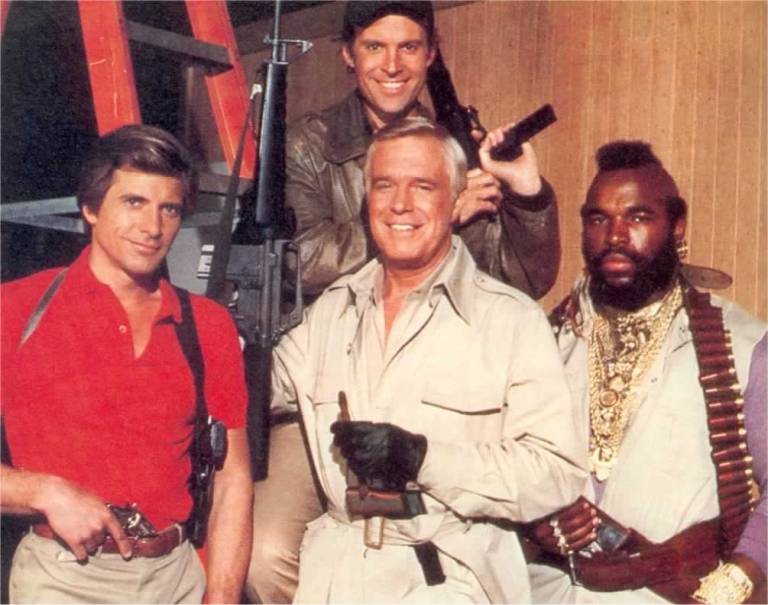
The 90s
The 90s bought much great TV however Crime Dramas were still trying to find their footing in the TV industry, the 90s bought us more gritty, serious and dramatic crime dramas. one early 90s example
Twin Peaks (1990-1991)
One early 90s popular crime drama that has a rating of 8.9 stars on IMDB is ‘Twin Peaks”, the show ran from 1990 to 1991 for only 2 seasons, however it is noted as being “Daring and provocative” TV show. The show is quite surreal and is often acclaimed for shattering the boundaries of the standard of TV dramas at the time.
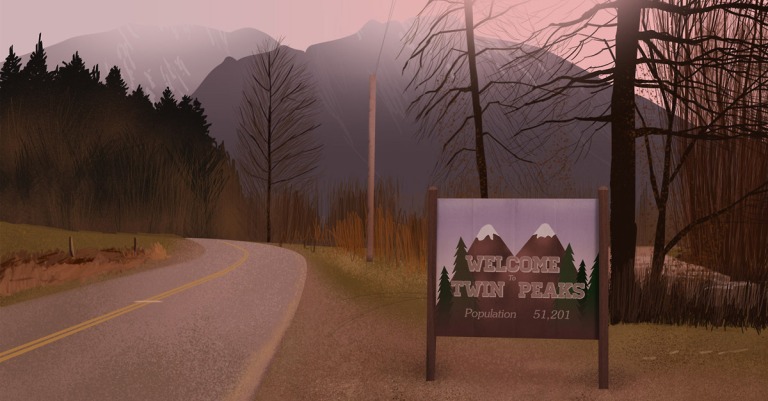
The Sopranos (1999-2007)
The 90s also bought us a show that is considered to be one of the greatest of all time, The Sopranos.
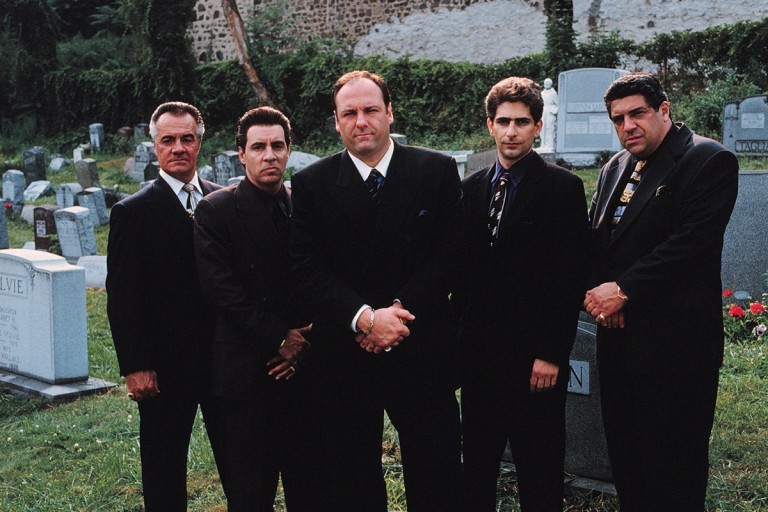
The Sopranos not only debuted in the very late 90s it also is what is praised for kicking off the golden age of TV in the 2000s, James Gandolfini’s portrayal on screen of the infamous anti hero ‘Tony Soprano’ is truly timeless and something that will never be replicated to this standard. Not only did The Sopranos influence great TV it has also played a huge part in modern culture, with many modern articles revisiting the show for its greatness and also the skate brand Supreme paying homage to the iconic ‘Sopranos’ logo with an exclusive Box Logo tee. The show is also insanely loved for its gritty and engaging and gripping storyline, everything that you need in a Crime Drama this show had. The Sopranos was also a very successful show in terms of awards, The Sopranos won 5 Golden Globes and another 113 wins and a further 301 nominations from around the world during its lifetime.
2000s
The 2000s is considered to be the golden age of TV, Crime Dramas were also hugely popular at this time due to the still on going powerhouse ‘The Sopranos’. During this time we were bought a lot of quality and fresh Crime Dramas. HBO was a powerhouse in producing these timeless classic Crime Drama shows, with the Sopranos ongoing success until 2007 we were then gifted ‘The Wire’ in 2002…
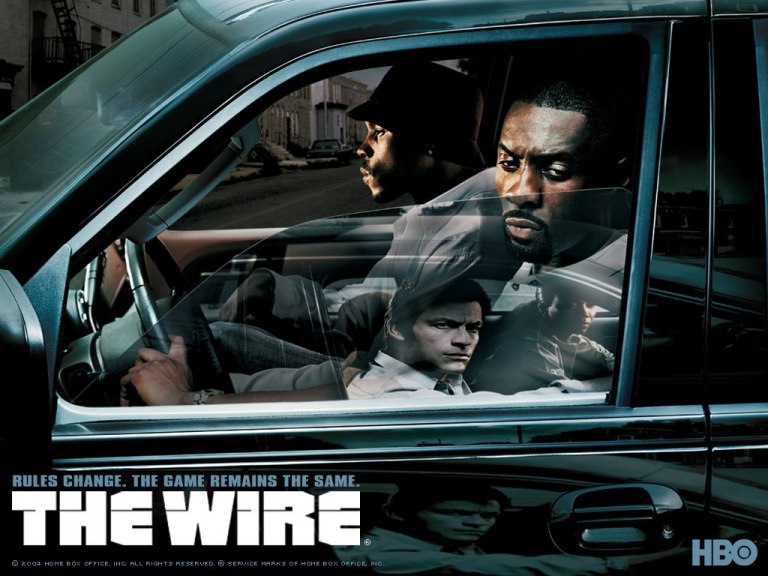
The Wire (2002-2008)
The Wire is another supreme crime drama produced by the American powerhouse of TV, HBO. The Wire is praised for being so smart in its design it was simply ahead of its time, the show is smart in the plot and how the show shows us that there are no good guys, the show is simply incredible, to summarise here is a review on IMDB that sums it up perfectly. (Plus I haven’t seen The Wire so this is needed)
2The wire is definitely the best show ever made. most realistic stuff ever. It takes a couple of episodes to get into it because it’s pretty slow compared to the average show but once you get into it, you just become addicted. unlike other police shows this one deals with ONE investigation during its 4 entire seasons while in other shows cases are closed in one episode. another good thing about THE WIRE is that we follow both cops and thugs without any superficial caricature we find on CSI and such, THE WIRE keeps it real all the way. incredibly well written, amazing photography and outstanding actors, this is the kind of show that should be covered with emmies…” -IMDB User: Critikal, Published 6th June 2005. Accessed 10/11/2017. Link: http://www.imdb.com/title/tt0306414/reviews?ref_=tt_urv
The Wire could also been seen as a failure of a Crime Drama, the show didn’t win any prominent awards, in total the show won 4 awards. Seriously this is one of the most underrated shows, ever. And this is a shame because it is a masterpiece of the genre and hasn’t got the official recognition it deserves.
The 2000s also introduced us to Breaking Bad but I have analysed that in more detail later in this blog.
The 2010s
This is when British Crime Drama began to pick up and one fine example of a brilliant British Crime Drama is Sherlock, Sherlock is in the top 3 rated Crime Dramas on IMDB

Sherlock is one of the best examples of a British crime drama, the show is adored for being a modern update on the classic and famous story, the show is produced by the BBC and was a huge success in the UK, the series is heading into its 5th season soon and will undoubtedly have a decent turn out of fans when it is back on screens. The show is also hailed for being a great adaption of showing the classic story in modern times, this is also effective as it reaches a larger demographic by incorporating modern culture and settings into a timeless classic of a story
Question 2
To research what makes a good crime drama I went onto IMDB and looked up the top rated shows in the crime drama genre, below you can see that the top 3 are (Order descending from top rated to bottom) Breaking Bad, The Wire and Sherlock, from this quick glance I can see that only one of the top 3 is a UK crime drama, this also shows from my previous research on the early examples that this seems to be a US dominated genre from the start.
For this next task I decided to heavily analyse the top result so I can see what makes a great crime drama, so for this I analyse ‘Breaking Bad’

#1 Breaking Bad (US)
The reviews on this show are stellar, it seems very admired and acclaimed in not only the genres of crime dramas but in TV series as a whole. Most reviews on IMDB are 10/10 all complimenting the hooking and thrilling storyline with some even referring to it as a ‘beautiful work of art’.
What makes it so good?
To find this out I simply searched on google ” What makes Breaking Bad so good” and the first article is from the website ‘Business Insider’, a world renowned publisher of detailed analysis and consumer statistics, facts and opinions. Now I could just link the website and let you read the article, however I will analyse their headings (which give away the most admired things of the show) myself with my own opinions and analysis .

“You watch the show’s main character slowly change from the protagonist to the antagonist” -Business Insider
As a fan of this show personally I can confirm that this really is one of the best things of the show, it breaks the stereotypical convention of a crime drama theme of remaining the good guy that solves crimes throughout and has a happy ending, not in this show. The shows protagonist finds ways around the law, and becomes a criminal mastermind playing cat and mouse with the law. The show also gives us a mental and moral judgement of the main character (Walter White) as he slowly switches from an innocent, normal high-school chemistry teacher to a diabolical, murderous, self centred and senseless mad man. From this I can see that this is a hugely loved show because it isn’t conventional to the genre and the story is a backhanded switch from the conventional crime drama as we witness a protagonist go to antagonist however we are left wondering who is in the right as we know why he is doing what he is doing and what influences his decisions throughout, we really are left wondering who is morally right throughout.
“The fine attention to character and plot detail” -Business Insider
This part of the article highlights and praises the incredible attention to character and plot detail and this is very important in not just this crime dram but every crime drama because if nothing is developed or built on then where and what is going to happen? It would remain stagnant. However Breaking Bad goes beyond this by incorporating the most insignificant characters into early series/scenes and the viewer thinks nothing of them however they sometimes have the biggest effect on the story yet the show disguises them as minor roles but can leave the viewer stunned after the actor shows up, say, 2 seasons later, this also rewards viewers for being introduced to the character early.
A little boy may be introduced once in one season. At the time, his cameo may not seem noteworthy, but when he turns up two seasons later, the viewer feels rewarded for being introduced to him in the first place.
-Business Insider, Published Aug. 6, 2013, 5:51 PM, Written by Kristen Acuna
Accessed 10/10/2017
“The show constantly forces you to think about the direction of the current episode and overall series narrative” -Business Insider
My final headline I will analyse is how the show literally leaves you questioning everything and wanting more, Breaking Bad makes you think about each characters choices, every ending to a episode and what can happen next? There is also many flashbacks in episodes and flash forwards at the beginning of episodes, this is shown in the pilot episode in which we are introduced to Walter White in his underwear, recklessly driving an RV with what appears to be 2 corpses in the back and a unconscious passenger. The viewers are left baffled by this, wondering what the hell is happening however by the end of the episode we know the ins and outs of why, where and what is happening, the show has a pay off at the end of most, if not all episodes.

“Breaking Bad will not only be remembered as a TV drama that went out on top — creatively, and in terms of popularity — but possibly as a game-changer for underdog TV shows.”
http://ew.com/article/2013/09/30/breaking-bad-series-finale-ratings/
Published by James Hibberd on September 30, 2013 at 6:08pm// Accessed 10/10/2017
How Successful Was ‘Breaking Bad’?
Other than its huge success amongst viewers around the globe the show is also heavily acclaimed by many Awarding Boards, to this day the show has achieved an astounding (yet well deserved) amount of awards across the globe, the show peaked with 10.3 Million people tuning in to watch the final episode. Breaking Bad won a combined total of 110 awards and nominated for a further 262. And the proof behind these accolades really is in the pudding. If you haven’t watched Breaking Bad I highly recommend you do.
What to take away from this research?
From this I could incorporate some of Breaking Bad’s unique codes and conventions into my project, for example below are some noteable codes and conventions I found when researching this show.
- An opening that throws you into a moment and leaves the viewer wondering where and what will happen next.
- Good attention to detail in scenes and character development.
- Possibly a surprise that could catch the viewer off guard (early on or opening scene possibly)
I’d love to use the conventions above in my media project as it would convey those used in some of the best shows, and really show my research has been done in depth and can be executed as shown in some of the best crime dramas.
Question 3
Here is the vox pops we conducted around Exeter, the questions used are noted below:
-Do you ever watch Crime Dramas?
-Have you seen Breaking Bad?
-Where do you usually watch Crime Dramas?
-Do you prefer to binge watch or watch them an episode at a time?
These questions weren’t really helpful to the research which we found out after reviewing them, what we could do next time if we were to re do Vox pops on Crime drams would be to ask the respondent what they expect, what themes they see in crime dramas etc. Some questions that would help develop the idea and help us get some more relatable and sought after content in our ideas.
Question 4
For my scene analysis I decided to analyse the opening scenes to ‘Breaking Bad’ and ‘Luther’. I decided it would be best to analyse not only a British and American crime drama openings but also 2 of possibly the best series from each country. Below is my breakdown of the standout scenes, differences and similarities:
Breaking Bad
Standout Scenes
The 1st episode opens with some establishing shots of the area, a isolated desert is what we see. This is effective as it makes us wonder why are we starting in such a rural location. This also sets the scene for what will happen next again prompting the viewer to think about the backstory as to why and how the characters have got there.
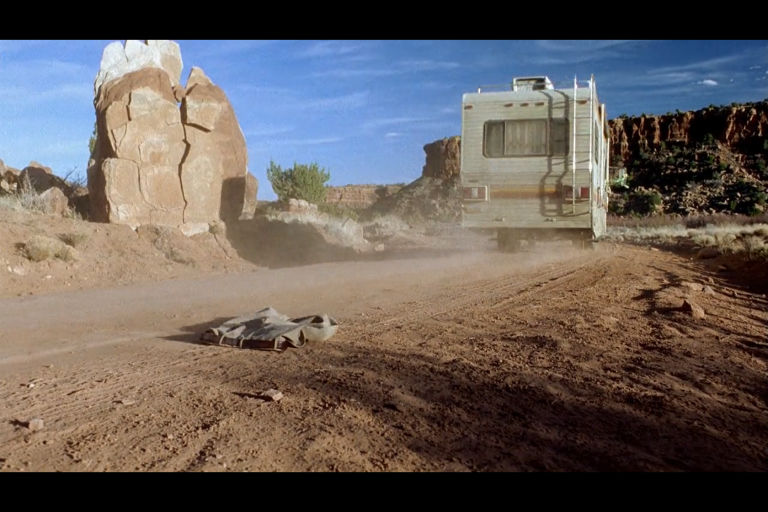
The next scene(s) in my opinion are rather surreal in a way. After the Establishing shots we are then greeted to a falling pair of trousers and a RV be driven in a rather ecstatic way, however in this scene Rule of Thirds is used very well as it shows the RV driving at a fast pace, Rule of thirds is used well as the vehicle enters from the left side of the frame and proceeds to drive around a corner on the right side of the scene in the 3rd section of the ‘grid’, very subtle but very effective.

We are then introduced to the first character, again, in a slightly surreal and twisted way, however this makes us wonder who the hell is he? Why is he in a gas mask? Is this a protagonist or antagonist? If you’ve seen Breaking Bad there’s a reoccurring theme to show the ending or resolution at the beginning, this engages viewers as we see during the episodes what happens in the build up, the show also makes us make our own decisions as to what and who is morally correct. The opening to Breaking Bad is no exception this scene left many viewers engaged from start to finish.
We also have questions as to who the unconscious passenger is and why there are also unconscious or dead bodies in the back along with lab equipment, very effective in keeping the viewer on the edge of their seat and engaged and wanting more
 Another brilliant use of Rule of Thirds, this time including the location and erratically controlled RV, appealing to the viewer as we see the location and we can now begin to slightly piece together what is happening.
Another brilliant use of Rule of Thirds, this time including the location and erratically controlled RV, appealing to the viewer as we see the location and we can now begin to slightly piece together what is happening.
In the first image we see the RV veer off course and into a ditch, this shot is very effective again as we see the impact and a follow up shot of the driver exiting the vehicle, the establishing shot of the driver examining the crash is show with the mixed emotion of anger, frustration, shock and fear (as there is sirens in the distance more in that later in the blog) the shot is also very well as it shows the RV in one half of the screen with the location covering the other half, the action also takes place in the other half of the screen, a small detail that I realised but very effective as it splits the scene but in a low key secretive way. Below I have shown the split in the screen.
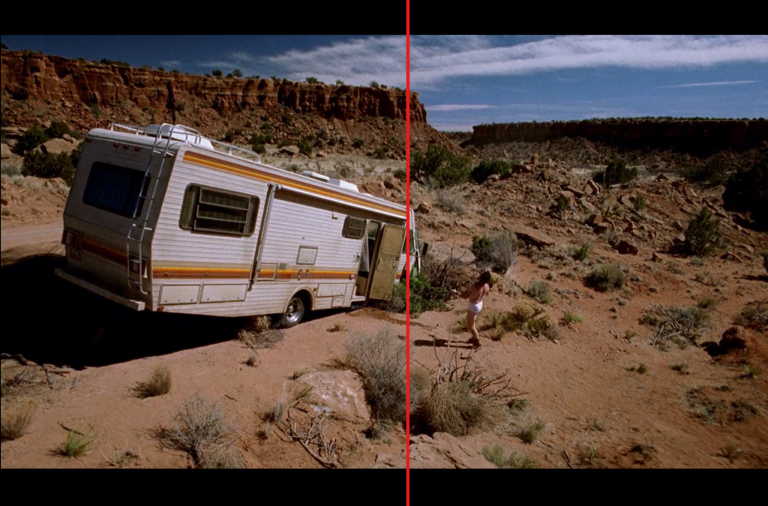 As you can see the scene is split so action happens on one side and the rest is purely visual, a nice touch which makes this scene very appealing. This scene also makes us wonder why they are in such a secluded and remote area, this show is brilliant at engaging the viewer and isn’t short of though promoting scenes and story lines.
As you can see the scene is split so action happens on one side and the rest is purely visual, a nice touch which makes this scene very appealing. This scene also makes us wonder why they are in such a secluded and remote area, this show is brilliant at engaging the viewer and isn’t short of though promoting scenes and story lines.
Mid Shots are the main shot used to introduce us to the character and are also mainly used in scenes with dialogue. This shot is executed perfectly as it shows the mix of emotions, props and location. The director has also been very skilful by placing the subjects in the centre of the scene so we know what we should be looking at, we are automatically drawn to these details, as its the opening scene there isn’t much small features to look for however the director is smart in making these small details obvious, for example in a heat of the moment panic we see Walter putting his wallet on the floor, drawing us to what is important and helping us piece what is going to happen together, this shows that the next step is shown, planned out etc to reward the user for predicting correctly or piecing it together, making the viewer feel like an inspector in their own right.

Before we go to the title sequence we see a long shot of the main character (Walter White) walk out onto the road holding a gun, in the distance we can hear silence, this shot shows he is ready to confront the consequences of his currently unknown actions, this scene also builds a good amount of tension and suspense which isn’t resolved in the first few episodes, this is smart as it keeps the viewer engaged until the pay off however there are other arches which pay off at the end of most episodes. Breaking Bad is insanely good at keeping viewers plugged in.
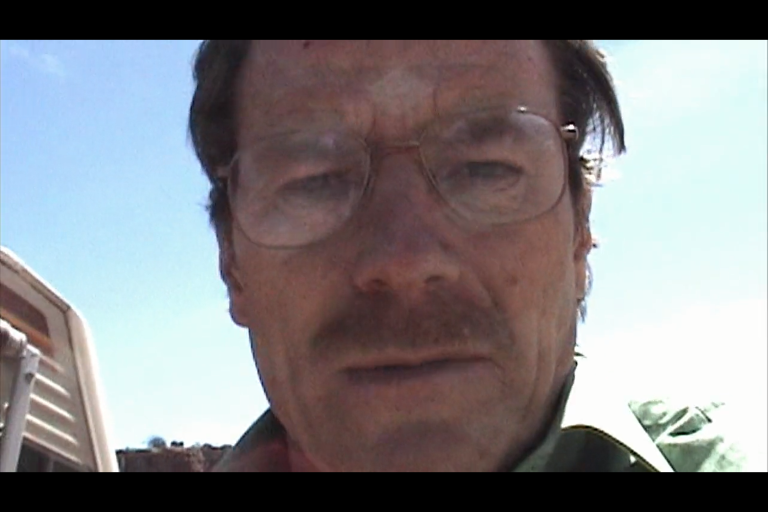 Found footage is used in the opening scene to incorporate a Close-up into the mix, an effective way to show Walter’s emotions as he records what he believes is his final moments, this is also a very good way to use shots without making it feel repetitive by adding more viewer involvement as it feels like we are watching the footage although we are just watching him through the cameras perspective. The low angle looking up also shows he is power despite looking in fear and shook by the current chain of events.
Found footage is used in the opening scene to incorporate a Close-up into the mix, an effective way to show Walter’s emotions as he records what he believes is his final moments, this is also a very good way to use shots without making it feel repetitive by adding more viewer involvement as it feels like we are watching the footage although we are just watching him through the cameras perspective. The low angle looking up also shows he is power despite looking in fear and shook by the current chain of events.
Sound
Sound in the opening is very minimal, we begin with shots that appear to be stills but can hear wildlife and wind faintly, we also hear the RV driving on the grit/dust road, we can also hear glass clanking and hitting glass as in the back of the RV there is a lot of Lab equipment. Sirens can also be heard in the background and they gradually get louder as the scene progresses (also showing that they are getting closer). Sound is used very well to build up the tension and make the opening seem more hectic.
Luther
Standout Scenes
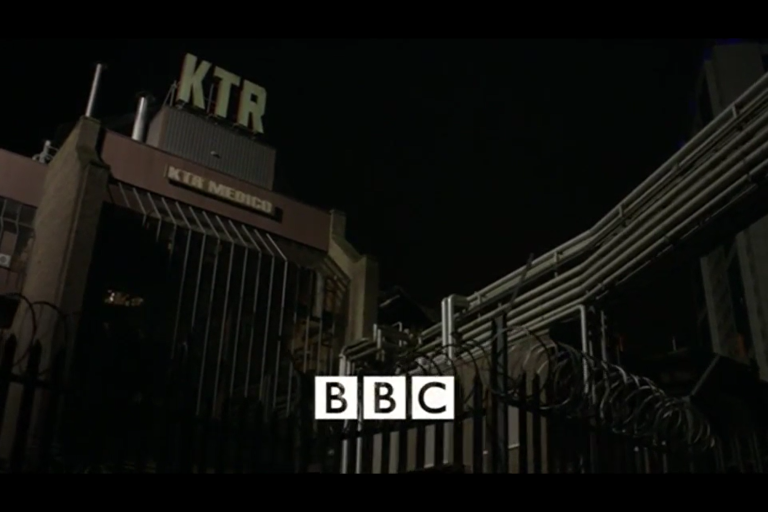
The opening shot to the original BBC Crime Drama ‘Luther’ is an establishing shot of the location, the location looks to be an old derelict factory (Later confirmed throughout the opening) this is effective as it shows us the stereotypical grimy, dark and gloomy industrial buildings commonly portrayed in many Crime Drams, a common convention in the genre used well.
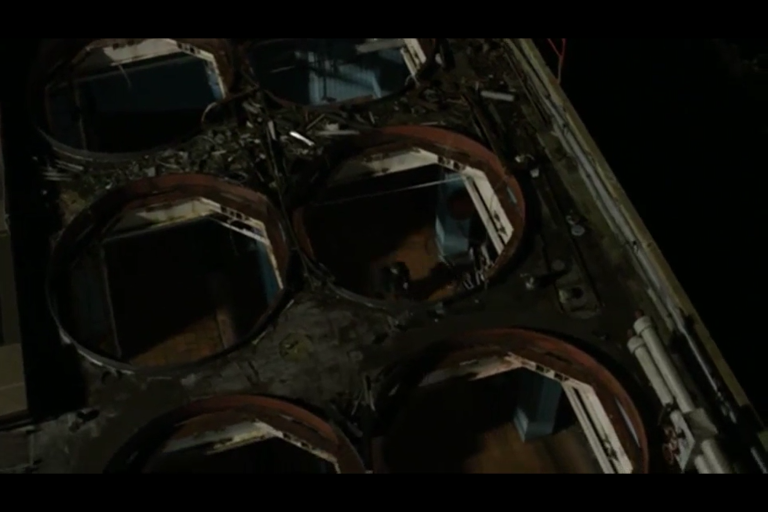
We are then introduced to a character running away as if he’s being chased or apprehended, a high angle looking down shows us the disrepair the location is in and also portrays the character as weak as he frantically looks around out of breath, the low angle makes him look weak and inferior but we don’t know what or why he is in this state yet as this is only 2 shots in.
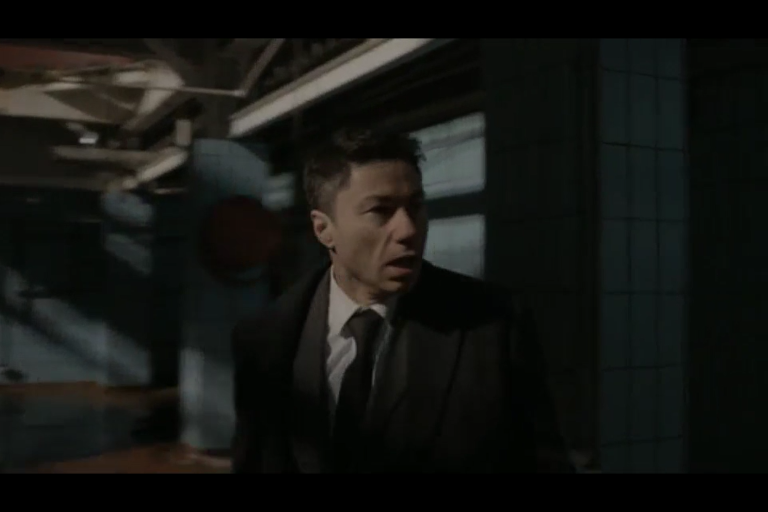 We are then introduced to the subject who is running from something or someone and he unsurprisingly looks like a figure of importance or authority, this is shows as he is dressed in a suit and tie as you’d usually see a businessman dressed in, the mid shot gives the viewer a quick look at him and what could possibly be happening. From this and the way he is out of breath from running away we presume he is being chased or hunted down by someone.
We are then introduced to the subject who is running from something or someone and he unsurprisingly looks like a figure of importance or authority, this is shows as he is dressed in a suit and tie as you’d usually see a businessman dressed in, the mid shot gives the viewer a quick look at him and what could possibly be happening. From this and the way he is out of breath from running away we presume he is being chased or hunted down by someone.
 We then get a glimpse at the man pursuing the suited man running away, in this scene we see the first shot of Luther, the main protagonist (Or Anti-Hero) of the show, we only see a mid shot of him following the man but this helps aid us into why the first character was fleeing. This shot also shows Luther as fearful and dominant, the first man is running away, note the action running, Luther however is walking at a steady yet fast pace showing he is in control of the situation by letting the man run he is also showing that he is patient, a skill most detectives and inspectors in Crime Dramas need.
We then get a glimpse at the man pursuing the suited man running away, in this scene we see the first shot of Luther, the main protagonist (Or Anti-Hero) of the show, we only see a mid shot of him following the man but this helps aid us into why the first character was fleeing. This shot also shows Luther as fearful and dominant, the first man is running away, note the action running, Luther however is walking at a steady yet fast pace showing he is in control of the situation by letting the man run he is also showing that he is patient, a skill most detectives and inspectors in Crime Dramas need.
After the chase scene we get our first look at the crime scene, in this scene we are introduced to 2 more detectives, one female and one male, within the genre there usually is a prominent female character and we are introduced to her early on, from this we can presume she is a protagonist as she works for the police force and is on hand at a crime scene however this could be a skill to project a over arching storyline in the series ( I haven’t watched this series, that is purely an opinion). The setting is a suburban street with Police cars and an Ambulance in sight, very conventional of the genre, we also have the flashing blue lights and other officers to make the scene more authentic.
 Once Luther apprehends the running man on a industrial factory lift by the looks of things, on this though they have a slight stand off thus building tension as we are now at the peak of the build up of a thrilling fast paced chase, this long shot establishes the scene which is very pleasing as we are now waiting for the action of what will happen next.
Once Luther apprehends the running man on a industrial factory lift by the looks of things, on this though they have a slight stand off thus building tension as we are now at the peak of the build up of a thrilling fast paced chase, this long shot establishes the scene which is very pleasing as we are now waiting for the action of what will happen next.
After the confrontation as the fleeing man meets a dead end he picks up a pipe to use as a weapon against Luther (who he has been running away from), this scene doesn’t only spark a brutal apprehension but also reveals Luther to us, he stands very dominantly and is very intimidating in his posture, whereas the man who he has been chasing stands very scared hence why he has equipped himself with a weapon.
Close ups of both characters are used in the build up and after the climax, this is another very good way to build tension and show emotion, the use of these shots date back to being used in many western films, a common shot used during many scenes of tension and confrontation. Their use of being able to convey the emotion is what helps them so good at making a scene grab the viewers attention, we are allured to the characters mind frame and feelings in that situation.

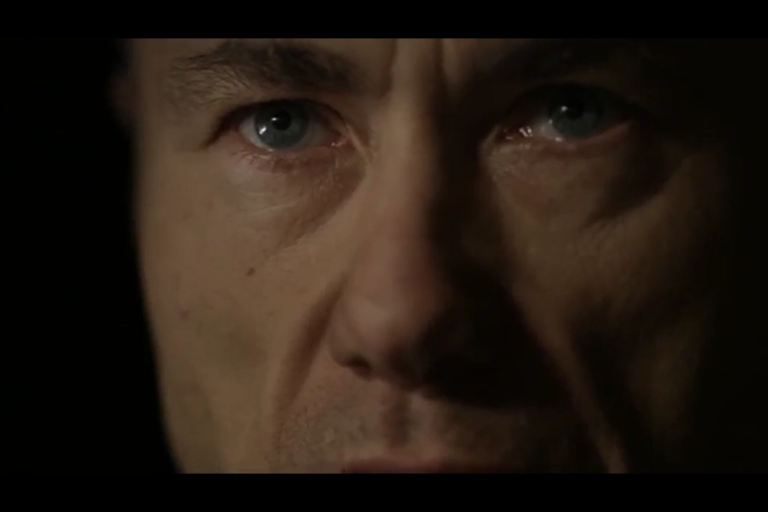 Extreme close up are then used right before the action, this is very helpful as it brings the tension to the wire, any more shots would’ve out drawn the tension and ruin the build up, the extreme close ups are used brilliantly to show emotion right before the climax.
Extreme close up are then used right before the action, this is very helpful as it brings the tension to the wire, any more shots would’ve out drawn the tension and ruin the build up, the extreme close ups are used brilliantly to show emotion right before the climax.
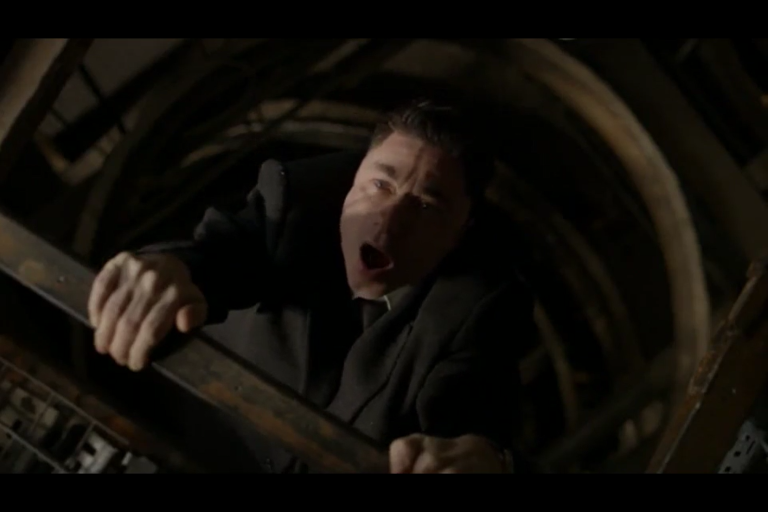
After a mis step in the derelict factory the antagonist is left hanging to a deadly drop pleading for Luther’s help, however Luther uses this to interrogate him and get intel off him to assist with the case for the officers previously seen in the earlier crime scene clip, we really see a man pleading for his life but a seemingly emotionless Luther stands by watching and waiting for his eventual demise while on the phone to the other detectives,
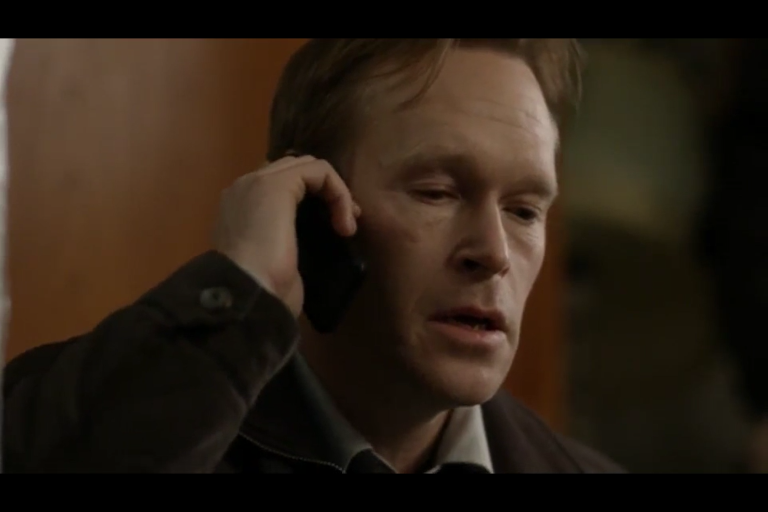
While on the Luther is on the phone to the other detectives thy can also hear the man pleading for help as he slowly loses his grip over the deadly drop, a close up and the audio can be heard through the phone to show the shock on the detectives face, he looks frozen as what he is hearing looks to haunt him.
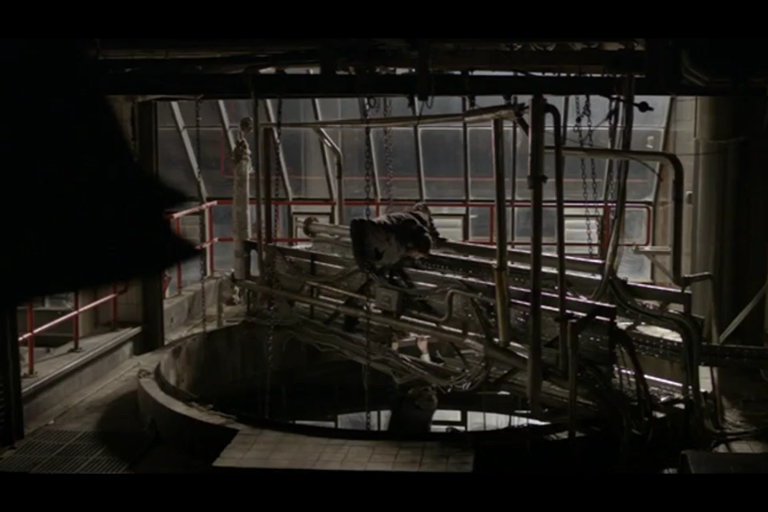
When the antagonist finally falls to his death there is a long shot that shows Luther’s reaction and this shows us he is now shocked, guilty and regretful about what he has just done (this is also shown in the close ups).
These emotions can also be shown from when he looks down at the body, the use of a low angle looking up at Luther shows he is in power as he has just killed a man, this shit is also used to look down on the dead body, showing he is inferior as he is deceased.
Yet this was also used when the man was pleading for his life, the camera always portrayed Luther as the more superior and dominant character with the low angles that looked up at him, not only does this make him intimidating but also shows that he is in control of the situation
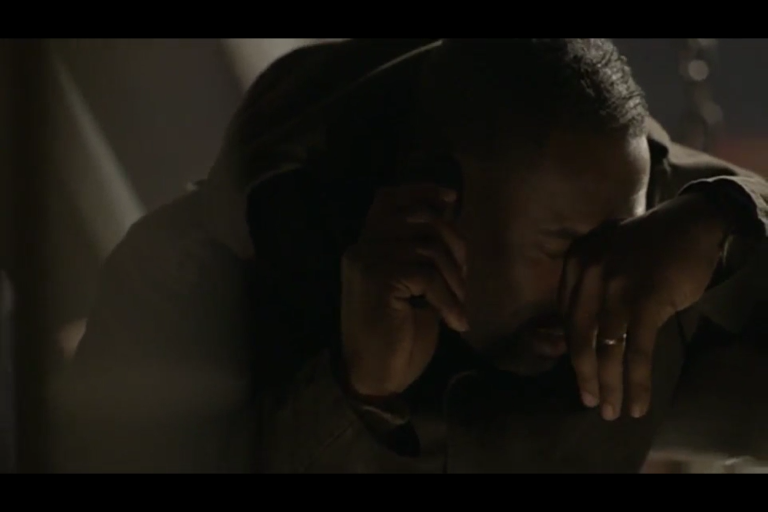
However Luther’s interrogation of the man does assist with the actions of the other detectives as they find a missing child hidden in the house they are at, so the opening shows us 2 things, Luther has done 1 good thing and one very bad, sinister thing, this portrays Luther as an anti-hero in the opening of the show so just imagine how unhinged he may become later on in the series…
Sound
The sound in Luther is very loud, throughout the opening from when we see the chase we here the echoing footsteps, the metal stairs and police sirens are just a few of the most dominant noises in the opening, these are helpful as they establish and the scene of a dark location and a literal crime scene.
I specifically love the use of the sounds used in the as they’re very industrial and sound daunting as they echo throughout the derelict site, a very good use of this is shown when the antagonist falls through a weak spot on a industrial lift, we can hear metal poles and sheets crash and upon impacting the floor we hear them echo loudly, this is also effective as it shows us high far they fell also aiding us in picturing how far he could possibly fall if he lets go
Comparison
Breaking Bad and Luther are both very unique Crime Dramas in their own right, and this is obvious and they show to be very strong and engaging shows from their openings. The shows share a few common themes which are also expected from their genre, for example both shows use weapons during some sort of confrontation (Walter as he waits for the oncoming sirens and the man fleeing Luther also arms himself with a metal pipe when apprehended by Luther. The show also uses sirens to show the viewer that there is a presence of law and order however this is shown differently in both shows, Breaking Bad uses sirens faintly from the beginning and they gradually get louder as the scene progresses this helps with tension and also aids the pace of the story as they gradually get closer we wonder what will happen to Walter when they finally reach him. Luther however literally shows you the sirens with audio and visual as a car is arriving at a crime scene there are the blue lights and sounds. The shows also both use Anti Heroes, for example this is shown early on in Luther and slightly in Breaking Bad, for example in Breaking Bad we see Walter driving as if he is fleeing the authorities possibly, we also see lab equipment (if you’ve seen the series you would already know this is for drug making and also unconscious bodies on the floor, possibly dead. Also Luther is shows being remorseless before watching his suspect fall to his death another trait of a anti hero, both of the protagonists actions leave us wondering and question what is morally correct.
Research Evaluation
As you can see I have conducted a lot of research and analysis, however I believe I could’ve done my Primary research to a higher and more helpful standard as the qualitative data I collected wasn’t very helpful when it came to deciding an idea and what would help make my crime drama more relevant to what viewers want to see. However I believe I made up extremely well for this in my secondary research of analysing crime dramas on IMDB, analysing openings, common codes and conventions, reviews etc. This really helped me narrow down what I could use to get the most out of my idea. Quantitive data also showed me how highly rated the shows I analysed are, for example Breaking Bad and Luther have high viewer ratings and Breaking Bad also won a huge amount of awards showing me how successful it was. My secondary research also helped me see the differences and similarities in crime dramas, some themes that are recurring and inescapable within the genre, these are helpful as I can use these in my project to show that I have noted the common themes that most, if not all crime dramas share.
Research definitions:
Primary Research: Research that you go out and collect yourself (Vox pops, surveys etc)
Secondary Research: Researching online (Reviews, news etc)
Quantitive Data: Data that can be measured numerically (Facts and Figures)
Qualitative Data: Qualitative data describes whereas quantitative data defines
My Crime Drama Idea
Now we have been put into our groups we all began to write up our ideas, for this project I will be working with James, Tom, Harry and Chloe. Of the group I am Producer and other roles will be sorted as time goes by, however faintly the roles are, Chloe in Sound Production (Music and Foley etc), Tom as Camera Operator, James is main editor and Harry is director. These are subject to change depending on who’s idea we choose to produce.
Below I have pitched the idea, proposal, and a page of the script.
Idea 1:
For my first idea the scene would open to an investigator and his crew celebrating the near close end of a very long, draining investigation into a unknown cynical serial killer. After a trial of clues left by the murderer the crew are finally closing in on them, in the conference room where they are discussing their next plan and how great this has been the main inspector is left vacant in the room after being repeatedly congratulated etc. In the scene before the climax he has a word with himself, congratulating and reflecting on the moment while holding and looking at either a closing statement/dossier folder/bottle of champagne or wine etc. As he leaves the room and puts his jacket on he is attacked by a hooded/masked person with a bulky object (something like a fire extinguisher or a bat etc. After being attacked the screen would cut to black and after the title sequence would open to the opening scene which would be the investigators (seen at the beginning) investigating a dead body (location can be anywhere but preferably somewhere dark, like an abandoned place/alleyway etc).
How it could function
For this idea we could film in college or science block (anywhere that looks similar to a lab or conference room), we would need about 3/4+ actors, possibly more for the conference/ lab celebration scene, and about 3 on the murder set. I would like the conference scene to be dark/gloomy to set a dark mood even though they are celebrating, the murder investigation scenes could be in an abandoned place to add extra effect, for this location the natural lighting and the dirty/smashed windows and shadows would add a much more grimey and sinister feel.
My Script
 This is the opening scene to my idea, it is short and simple relying mainly on the scene aesthetics etc. This is only the opening as it was for my pitch, unfortunately my group did not choose this idea.
This is the opening scene to my idea, it is short and simple relying mainly on the scene aesthetics etc. This is only the opening as it was for my pitch, unfortunately my group did not choose this idea.
Single Camera Drama Techniques
Here is the video filmed and edited by me and Liam. Using Harry and Tom as our subjects we filmed the following shots from the Glossary below:
Glossary of Shots:
180 Degree Line: An imaginary line between the characters in the scene, in this scene we used the metal bollard(s) to show where the line is, the camera should stay on one side of this line throughout the scene.
30 Degree Rule: Shots which follow one another spacing each shot by 30 degrees, this didn’t really work well but is good enough.
Establishing shot/Long shot: A shot that shows the location/establishes the scene. I think this was done perfectly.
Shot Reverse Shot: For this shot the camera cuts from one subject of the 180 degree line to the other subject, often using an over the shoulder shot to show each character.
Eye line Match: This shot is used to match each characters eye line, so their perspective is what is being replicated in the shots.
Continuity Editing: The process of combining related shots into a sequence to show a story that the viewer can understand. As you can see in our video we have just pretend the shots in theory so there isn’t no story and the shots do jump between each persons body language etc. So continuity editing has not been applied in this edit as it was purely testing the shots.
Final idea
We decided to go with Chloe’s idea for our idea to make, below is our Pre Production work, a reflection and evaluation on the project and a link to the final edit.
Pre Production
Script:


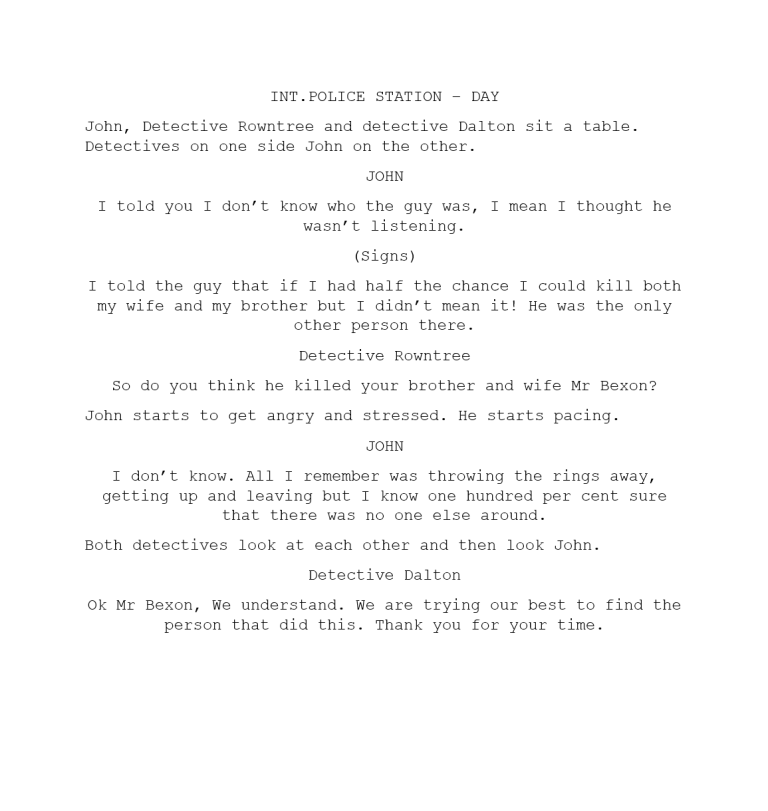
Here is the final script written by Chloe who was also assistant Director during the production of the film.
Storyboard:
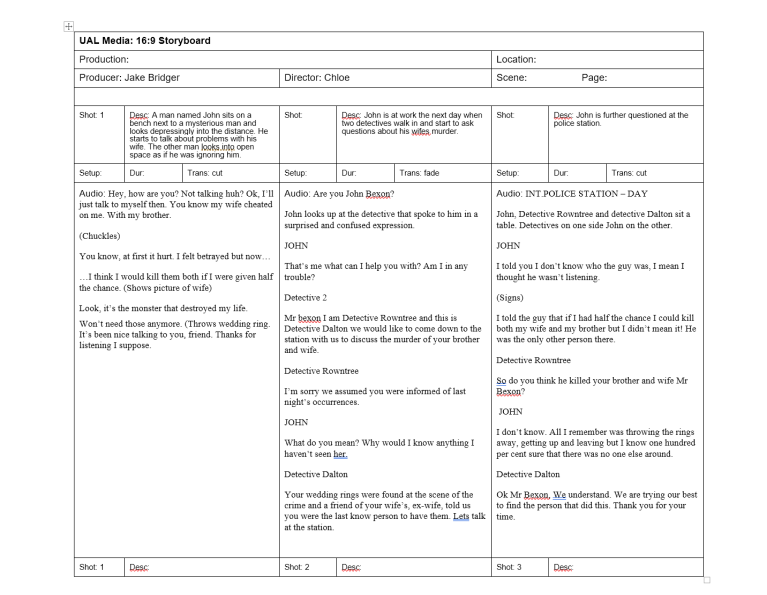 Tom then worked with the script writer to make a storyboard for the production however Tom wasn’t confident in drawing and was told it was OK to leave it blank however he has been very specific with the audio, dialogue and transitions.
Tom then worked with the script writer to make a storyboard for the production however Tom wasn’t confident in drawing and was told it was OK to leave it blank however he has been very specific with the audio, dialogue and transitions.
Risk Assessment:

 James then wrote up a risk assessment for the locations we would be filming at, luckily we were able to merge it into one document as we didn’t require permission for either location (classroom and public park), We couldn’t get signatures as this was done digitally.
James then wrote up a risk assessment for the locations we would be filming at, luckily we were able to merge it into one document as we didn’t require permission for either location (classroom and public park), We couldn’t get signatures as this was done digitally.
Location Recces:
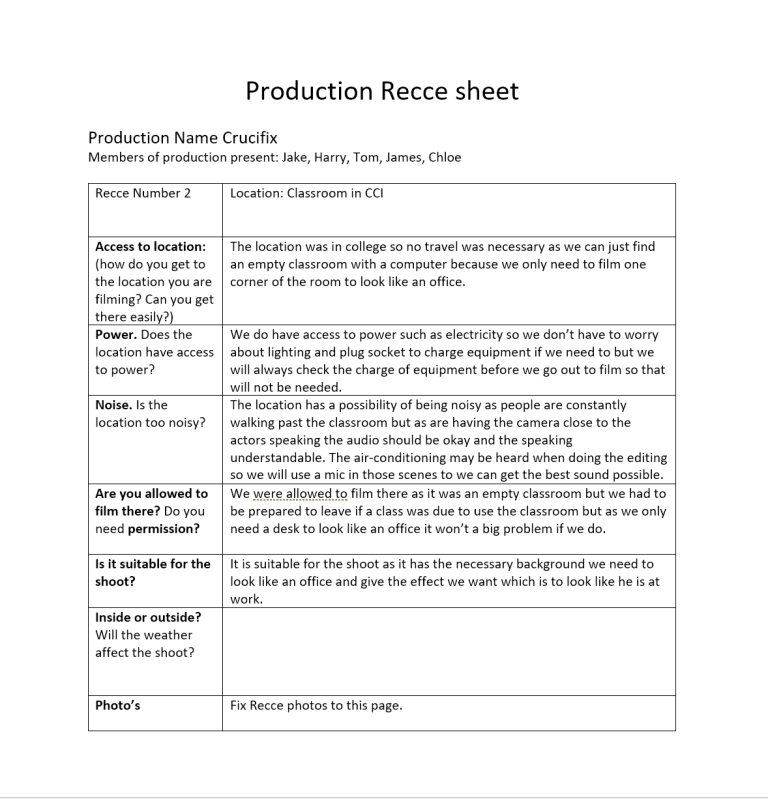
 Here are the Recces, the author of these is unknown as there isn’t a name on the sheet, these are detailed for both locations but lack photos of where we would be filming despite members of our group going out to scout these locations.
Here are the Recces, the author of these is unknown as there isn’t a name on the sheet, these are detailed for both locations but lack photos of where we would be filming despite members of our group going out to scout these locations.
Call Sheet:

Before we started filming we got everyones contact details in case we needed to contact a member of our crew at a moments notice, the most important number needed though was the Actor’s as without his we wouldn’t have been able to film something a wee bit decent.
The final Film:
Here is the link to the final edit, main sequence edited by James and Title Sequence edited by Harry and Tom. All our own footage as we were unfortunately not allowed to use 3rd party footage (we were told).












